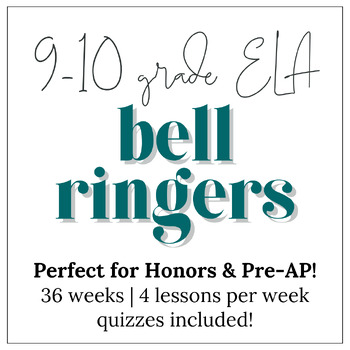ELA Bellringers for 9th & 10th Grades | Vocab Literary Terms Grammar | Full Year
- Zip
- Google Apps™

What educators are saying
Products in this Bundle (4)
Bonus
Also included in
- This ELA Bundle for Grade 9 and 10 provides thematic and genre-based units, lessons and notes for a full year of freshman or sophomore English, whether it be on-level, Honors, or Pre-AP. These units can be taught by genre, by unit, or a good mix of both. Nearly all of the materials for this resourcePrice $220.00Original Price $334.50Save $114.50
Description
This set of year long ELA bellringers will prep your grade 9 and 10 students in vocabulary, grammar, literary elements, and nonfiction analysis, especially those in Honors or headed for AP Literature and AP Language. This ELA bellringer bundle includes a beautiful student handout that you can print or assign digitally for note-taking.
Note: Note files and student handouts are in non-editable PDF and PowerPoint format, but Canva template links are included if you wish to edit! The quizzes are in editable Word format.
⭐ This set of ELA bellringers for Grade 9 and 10 includes the following focused activities:
Each week exposes students to four new words, selected from PSAT and ACT vocabulary lists for 9-10 grade students. Each word is paired with an example sentence and its part of speech.
Each week exposes students to a new nonfiction excerpt, specifically chosen for grade students preparing for upper level ELA courses like AP English Language or AP English Literature. Each lesson begins with a brief overview of the text followed by a CCSS-aligned question for analysis. An answer slide follows each question to make lessons succinct. These texts were selected to expose students to nonfiction texts and celebrated speeches that students must study in 9-12 grades.
Excerpts are between 2-8 sentences long and come from the following texts:
- The Jungle by Upton Sinclair
- The Declaration of Independence
- Educated by Tara Westover
- Oprah Winfrey's Golden Globe speech
- "Ain't I a Woman?" by Sojourner Truth
- Martin Luther King Jr.'s Letter from Birmingham Jail
- The Emancipation Proclamation
- Into the Wild by Jon Krakauer
- The Glass Castle by Jeannette Walls
- Franklin Delano Roosevelt's war message
- Me Talk Pretty One Day by David Sedaris
- "I Have a Dream" by Martin Luther King, Jr.
- In Cold Blood by Truman Capote
- Freakanomics by Steven Levitt and Stephen J. Dubner
- George Washington's Farewell Address
- The Immortal Life of Henrietta Lacks by Rebecca Skloot
- Thank You For Arguing by Jay Heinrichs
- Unbroken by Laura Hillenbrand
- "A More Perfect Union" by Barack Obama
- I Know Why the Caged Bird Sings by Maya Angelou
- The Gettysburg Address by Abraham Lincoln
- Radium Girls by Kate Moore
- Richard Nixon's resignation speech
- Night by Elie Wiesel
- On Writing by Stephen King
- Angela's Ashes by Frank McCourt
- Born a Crime by Trevor Noah
- John F. Kennedy's inaugural address
- Just Mercy by Bryan Stevenson
- The Woman Warrior by Maxine Hong Kingston
- I am Malala by Malala Yousafzai and Christina Lamb
- Black Boy by Richard Wright
- How Starbucks Saved My Life by Michael Gates Gill
- Statement on Martin Luther King, Jr.'s Assassination by Robert F. Kennedy
- The Devil in the White City by Erik Larsen
- William Faulkner's Nobel Prize acceptance speech
These literary terms were selected to expose students to higher-level ELA terminology that goes beyond the standard terms you'd find in a short story or poetry unit. You won't find simile, metaphor, or protagonist on this list, since that is often taught in younger grades and reinforced in other units. These were selected to prepare students for future AP Lit or Lang classes and for success on the SAT or ACT.
Here are the words your students will learn in this year-long ELA bellringer resource:
- Epiphany
- Antithesis
- Inversion
- Foil
- Satire
- Paradox
- Situational Irony
- Parable
- Tragic Hero
- Colloquialism
- Dramatic Irony
- Antihero
- Diction
- Epic
- Rhetoric
- Stereotype
- Hyperbole
- Conceit
- Apostrophe
- Parallel Structure
- Soliloquy
- Archetype
- Alliteration and Assonance
- Bildungsroman
- Aphorism and Idiom
- Elegy
- Understatement
- Parody
- Anthropomorphism
- Epigraph
- Pun
- Anaphora
- Metonymy
- Stream of Consciousness
- Deus ex machina
Each week gives students two sentence samples, each with 3-5 grammatical errors. Two answer slides follow with explanations to each grammatical principle to make lessons clear and succinct.
The exercises tackle the following grammatical concerns:
- spelling and word choice
- capitalization
- quotes
- verb tense or agreement
- parallel structure
- phrases, commas, and appositives
- formatting
- clauses and commas
- colons
- semicolons and conjunctive adverbs
- passive voice
- apostrophes
- conciseness
- dashes
⭐ Bonus
As a bonus, this bundle includes a printable student handout and 36 5-point multiple-choice quizzes for your Friday bellringer activity. These elements are included in the bundle only!
⭐ Looking for more bellringers for AP-level students?
My Literary Term bellringers and poem bellringers will help your students prepare for the AP Exam!
⭐ Get free TpT credits for future purchases!
If you like this resource, then I’d love to hear from you! Select “My Purchases”, choose ratings and leave feedback and you will receive free credits to be used on your next TpT purchase.
⭐ Are you following Lit and More?
Be sure to follow my store for updates on my constantly growing range of literature resources.
Follow me on Instagram @litandmore for daily updates, suggestions, and strategies!
Visit my website here where you can read my blog, sign up for my email list to receive updates, freebies, giveaways, and exclusives!






